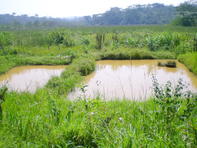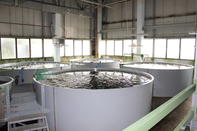The History of Rural Aquaculture in Africa
During the late colonial period in the 1960s, administrations in many African countries attempted to promote rural aquaculture, mostly of tilapia species.

At the time, commercial tilapia culture was in its infancy, so stock genetic enhancement and single-sex fingerlings were as yet unknown. The widespread failure of these initiatives and the lessons learned from these failures formed the foundation for a very significant increase in tilapia farming in the last 25 years worldwide.
The introduction of Oreochromis mossambicus (Mozambique tilapia) to Indonesia during the Second World War by the Japanese encouraged the widespread use of this species. Unfortunately, its unsuitability soon became apparent.
Reasons for the unsuitability of Mozambique tilapia include: Slow growth Massive reproduction Poor body shape and fillet yield Low disease resistance In the 1980s O. niloticus (Nile tilapia) became the only real commercial species.
The GIFT program - a selective breeding program for ‘Genetically Improved Farmed Tilapia’ - was developed in the Philippines and set the standard for high-quality fingerlings, which are now used worldwide.
Tilapia Farming Systems - Cage Culture
Tilapia can be produced in different systems. Cage culture in large lakes is widely practised in Lakes Kariba, Victoria and Volta, as well as in the Nile River. However, tilapia in cage culture systems is 100% dependant on expensive artificial feeds. Water quality conditions must lead to optimal growth in the shortest possible time period for economic viability.
The cost of tilapia feed is an important input and most such tilapia cage culture ventures are high level, vertically integrated corporate investment projects and not suitable to community rural aquaculture.
Tilapia Farming Systems - Re-circulating Aquaculture Systems

RAS (re-circulating aquaculture systems) is often promoted as the aquaculture method of the future. The volume of water used is limited and the environmental control in these systems is high.
However, these systems work best in peri-urban locations close to markets thus making the economic viability of RAS in rural communities problematic. Risks of total stock loss are high, especially due to these systems being energy dependent 24/7.
This then requires expensive automatic energy back-up, spares and skilled technical operation; all negative factors for remote rural environments or communities.
Tilapia Farming Systems - Earth Pond Culture
Rural communities are often remote from reliable sources of electricity. Thus aquaculture systems must be suited to the energy supply and skills levels available. In Southern Africa, these communities are often situated at low altitude or in areas with considerable water resources. Both these factors are attributes that favour earth pond culture of fish, especially for tilapia farming.
Irrigation dams, whilst not suitable as aquaculture facilities themselves, can offer bulk water for ponds before it is then used for irrigation. The positioning of tilapia farming projects below such dams or along irrigation canals is advisable.
The skill requirements for earth pond fish culture are easily learnt and do not require the level of sophistication and skills as required by RAS. Earth Pond culture is ideal for rural communities where such skills often do not exist at present.
By Nicholas James